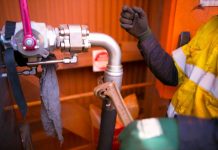Are you reopening your pool? Congratulations, it’s time for unlimited fun and enjoyment with your family and friends.
Hold your horses! Before you dive-in, you need to do certain things to prepare your pool for a long season ahead.
Don’t worry; reopening an in-ground pool after winter is easy, just follow the simple below step-by-step user guide.
Step 1: Remove the Pool Cover

During the fall and winter season, your pool cover does the job of preventing dust, debris, plant & leaves waste, and other unwanted stuff from getting into the pool water. While the water underneath the covered pool is probably clean, you still need to pump it out, and later you’ll fill the pool with fresh water.
But, before that, give your pool cover a thorough cleaning. Use a specialist market-available cleaner to get rid of stubborn stain marks, and then allow it to dry for a couple of hours.
When not in use, carefully, tightly roll the cover and store it inside the garage, away insects and rodents. Doing so, you prolong your pool cover’s life. Alternatively, you can consider a patio enclosure that provides a broader coverage to your pool and the pool deck.
Step 2: Inspect the Pool
Survey the surrounding area of your pool to identify any wear and tear. Trim the hedges and ingrown trees around. Sweep away the leaves nearby. Carefully examine the deck for damage, and address the problem right away. Be sure to fix the deck furniture so that it is safe for the summer ahead.
Now, coming to the pool’s finish. When the pool surface has completely dried up, look for any cracks or algae marks. Examine for chips in the plaster, indentations on the coping and deck.
Don’t forget to check the tiles and remove the calcium scale with a cleaner, baking soda, and tile brush.
Finally, check the pool equipment such as slides, rescue, safety rails, and diving boards for any damages.
Step 3: Gather The Necessary Pool Chemicals
You’ll need all the chemicals ready for reopening the pool. If you maintain a stock of chemicals, make sure you check the date, label and replace those which have passed their prime.
Read Also: 5 Tips for Touching Up Your Yard
Be sure to dispose of the chemicals safely and in an environment-friendly manner. Besides, get rid of the chemicals which were not properly sealed when stored.
A Quick Chemical Checklist for Pool Chemicals Include:-
- A test kit or test strips for checking the pool’s alkalinity, calcium hardness, pH, and chlorine levels.
- Chlorine tablets or granules.
- Increasing & decreasing chemicals for alkalinity, calcium, and pH.
- Algaecide chemicals.
Step 4: Switch on the Pool Filter & Test the Water
So, you’re almost there! All you have to do is to set up the filter and switch it on.
Turn on the filter for 12 to 24 hours. After that, check the chemical balance of the pool water using a test strip.
The pH value should be between 7.2 to 7.6, and alkalinity has to be between 120-150 parts per million. The ideal calcium hardness level is between 200–400 ppm.
Based on the test results, you’ll know much and which chemicals you require.
Again test the water, and repeat the process till the chemical balance is not achieved.
Don’t have time or feel confident testing the water yourself? You can take a sample of pool water to a local testing centre for proper analysis. In addition, they’ll provide you instructions on using the pool chemicals.
Be sure you check the filter and the return lines for any leaks, cracks, and damages. If you are using the sand filter, then add sand to it. For a cartridge filter, check the cartridge, clean or replace it.
Let’s Wind Up
Finally, when your pool water is free of debris, the right chemical balance is accomplished, your swimming pool is ready to jump in!




























































